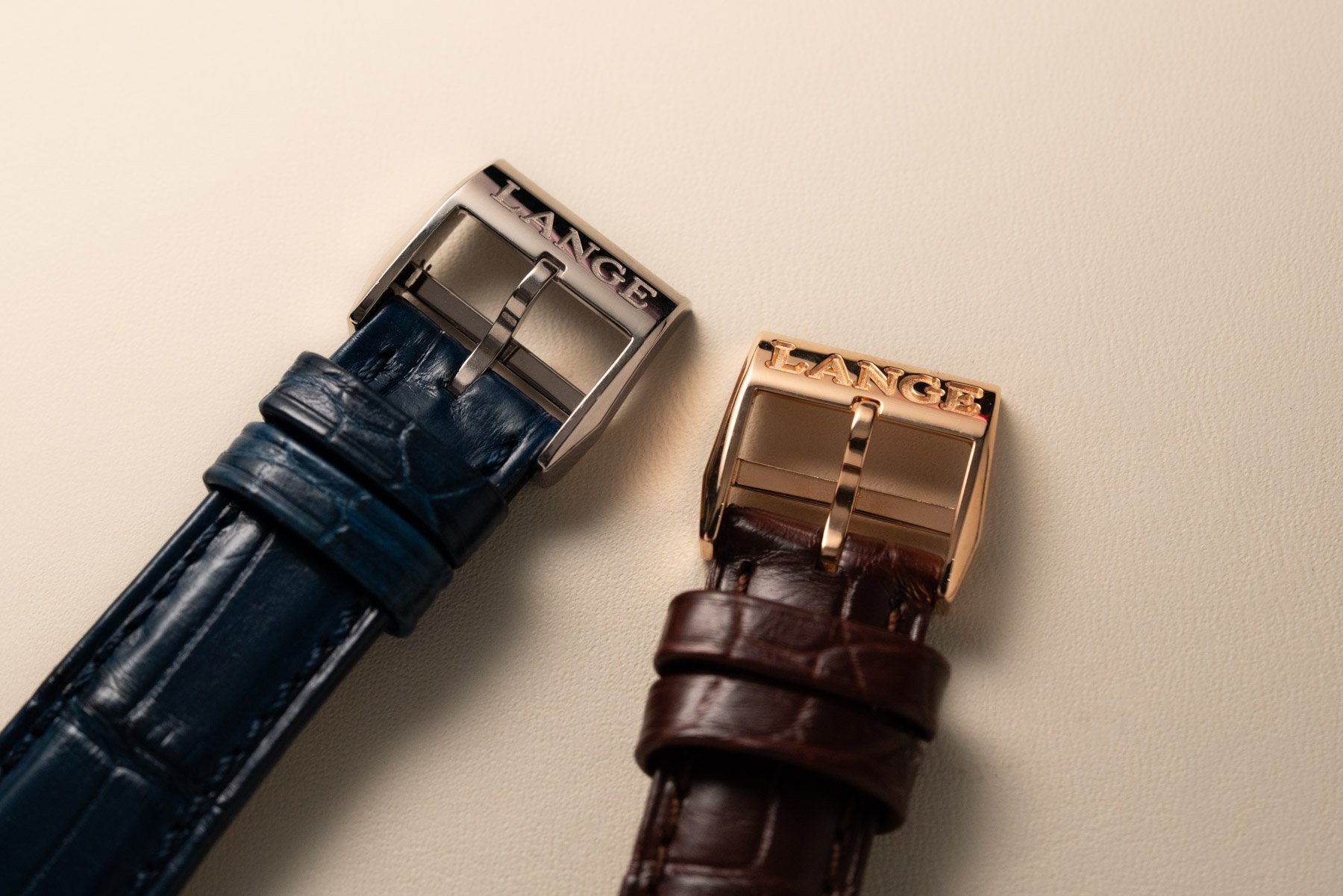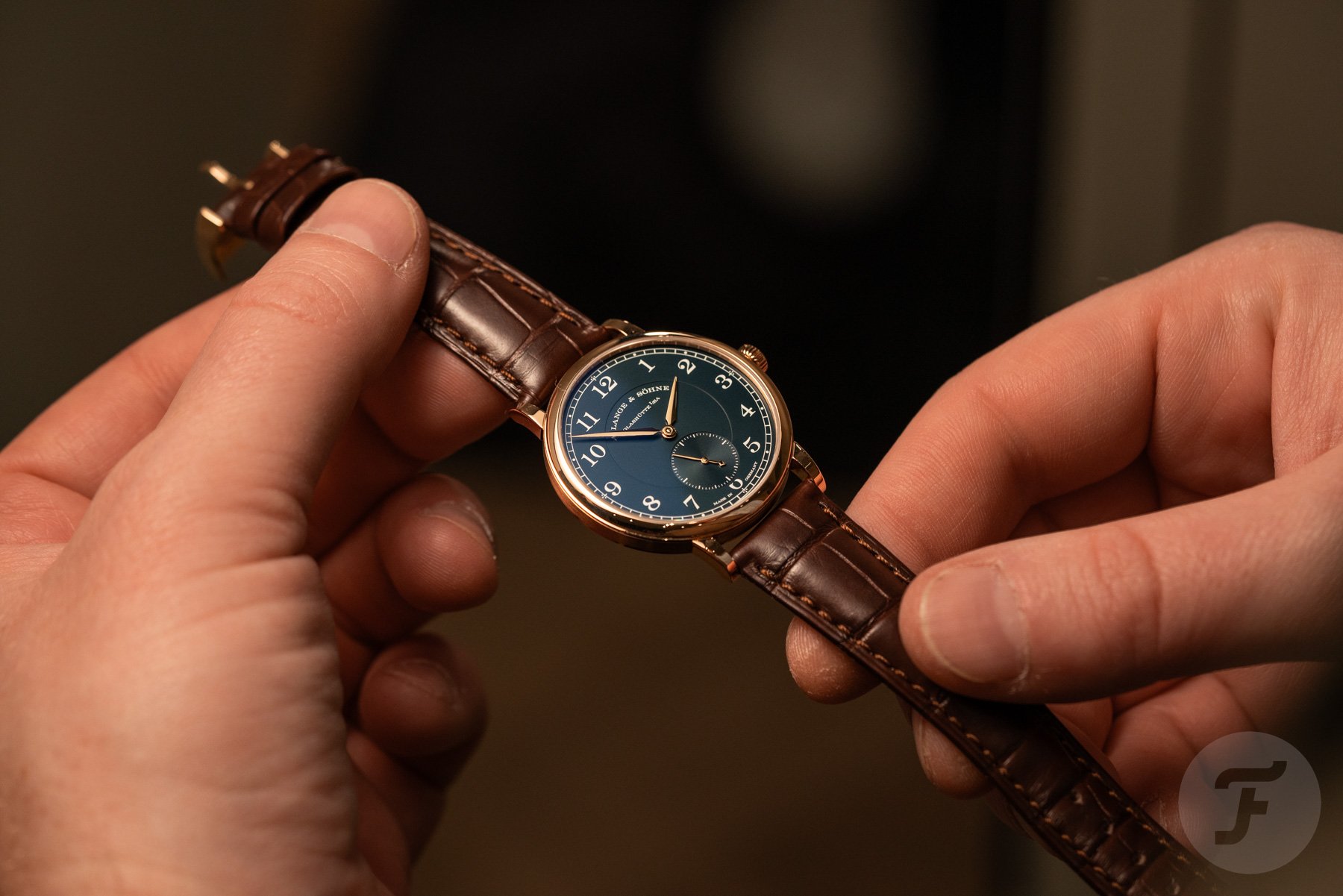Hands-On With The 34mm A. Lange & Söhne 1815
One of the understated hits this year at Watches and Wonders was the 34mm A. Lange & Söhne 1815. If this is the peak of the trend for slight watches, then we “small-wristers” have been well rewarded. Today, we’ll take a closer look at the two variants of this charming dress watch.
The longstanding 38.5mm 1815 from A. Lange & Söhne doesn’t exactly qualify as a behemoth. Still, the brand saw an opportunity to offer a smaller watch. Indeed, appealing to those who enjoy a more discreet look on the wrist isn’t the worst idea. Plus, a new 34mm case works on a smaller wrist and works for women. As we’ll see, though, the latest 1815 wasn’t only about downsizing. Lange has introduced a new caliber, its 75th, in this model.
The 34mm A. Lange & Söhne 1815
Lange introduced the new 34mm 1815 in two forms. Its case is made of 18K white or pink gold and houses a blue dial. As we’ll see, the watches strictly adhere to many Glashütte design tenets. An example is the use of 925 silver instead of brass for the dial.
Each comes with a polished and lightly padded alligator strap and a matching gold pin buckle. The water resistance is typical of dress watches at just 30 meters.
A magical case
I’ll detail the new movement shortly, but rest assured that it contributes to an incredible form factor. The larger 38.5mm 1815 is no porker at 8.8mm thick, but the latest 34mm version comes in at just 6.4mm slim! That’s incredible, but it’s not so thin that it feels delicate or fussy. Looking at the case profile reveals curved lugs with horizontally brushed sides, polished chamfers, and tops. The mid-case is where the watch truly shines, though. More horizontal brushing is sandwiched by two thin layers of polished metal. The outermost layers form the bezel and case back.
The L152.1 — Lange’s 75th caliber
I originally mistook the 34mm 1815 movement for an existing caliber. After all, Lange’s hand-wound powerplants have a distinct, recognizable look. This was incorrect, though, as the brand created the new L152.1 for this watch. It’s technically impressive too. Lange regulates the 21-jewel caliber to five positions for accuracy. The frequency is moderate at 21,600vph, which allows for 72 hours of power reserve.
Regarding finishing, this is where Lange hits its stride. The traditional three-quarter plate was introduced by Ferdinand Adolph Lange in 1864 and has become a hallmark of most watches from the area. Here, it is finely decorated with Glashütte ribbing and shows off anglage on the exposed edge. A hand-engraved balance cock completes the expected appearance for a movement from this part of Germany. Finally, note the chatons housing the four visible jewels. I normally prefer plentiful bridges, but it’s hard to argue with the Glashütte tradition.
Addressing the (small) elephant in the room
For those who follow horological news, the idea of the watch media fawning over a smallish 34mm piece like the 1815 probably borders on nauseating. Indeed, the reception has been overwhelmingly positive. Groupthink, overexcitement about a new case size, and so on are likely some of the thoughts that come to mind. Normally, I’d agree, but despite the slow crawl to more moderate case sizes, most brands have refused to breach the 36mm threshold (even going below 37mm has been a challenge). That’s what makes this new Lange so significant.
My brief visit to the Lange booth at Watches and Wonders elicited a relatively uncomfortable rationale about the new 1815 from one of the employees. It was a mix of “we wanted to do something smaller” and “this watch could be good for women.” As a result, I honestly think that many Lange associates were surprised that so many men liked the watch. Perhaps it didn’t compute with the original intent, but more admiration rather than less is always a positive.
On the wrist
Before moving to London, I never would have considered a 34mm watch like the 1815. Thanks to collector friends who enjoy smaller ’50s pieces, I now rarely wear a watch larger than 36mm. Lately, peak comfort for me is defined by a simple 34–35mm vintage watch (which is probably defined as a dress watch in today’s terms) on a strap. This type of watch is light and airy. More importantly, watches like this direct the focus on whatever case, movement, and dial details are present. There’s no hoopla or superfluousness. In other words, the watch stands on its own, and it has to be good or else! “Sure,” you’re probably saying, “but the same can be said about a larger dress watch.” Well, I disagree.
I get it that large-wristed folks tend to like larger watches, but it’s okay to wear a smaller watch on a larger wrist. The reality is that more time has passed with smaller watches dominating the scene than larger ones. We have choices now, which is great, but sometimes reconsidering a watch like the 34mm 1815 requires a mindset adjustment of what fits. Let’s come back to why a large-diameter dress watch doesn’t work as well. Honestly, they often look like dinner plates (hello, Patek 6119) and have too much space on the dial. Plus, they wear like a huge slab on the wrist. Dress watches aren’t supposed to be showy, which explains why this 1815 approaches visual and wearing perfection for many of us who saw these watches in Geneva.
Final thoughts on the 34mm 1815
Let me get one thing out of the way: I should have picked the new 34mm 1815 for my list of favorites from Watches and Wonders. It was an oversight. This is a great release that I will seriously consider if I’m fortunate enough to shop in this price bracket again. Lange lists these watches as “price upon request,” but we’ve uncovered a price of approximately €27,000. That’s an expected price for a watch that competes with the usual top brands. In other words, it’s expensive but somehow accepted. Plus, unless a ’90s model from another brand is in the running, the 1815 is a distinct, smaller choice for now.










